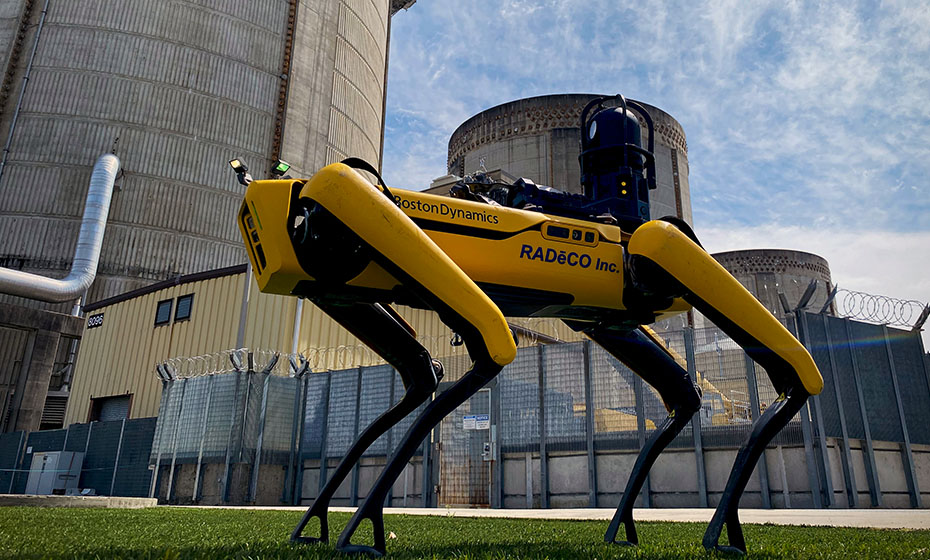Spot the Robot Dog Helps Humans Inspect Nuclear Power Plant
Oconee Nuclear Station’s robot is one of the latest ways Duke Energy uses innovative technology to generate cleaner energy that’s affordable, reliable and safe
Published 05-09-22
Submitted by Duke Energy
Duke Energy’s Oconee Nuclear Station has a new dog. “Spot” can sit, lie down and roll over. Unlike your average Rover, Spot is also trained to perform inspections of hard-to-access areas at the plant on Lake Keowee near Seneca, S.C.
Spot, purchased in 2021, is the newest inspector gadget to join Oconee and the company’s growing pack of robotic technology. Duke Energy’s nuclear plants are operating even more reliably and efficiently because employees are using new technology while producing carbon-free energy 24 hours a day. Nuclear power is a key component as Duke Energy works toward achieving net-zero carbon emissions by 2050.

The four-legged robot is roughly 2 feet tall by 3 feet long and embodies the latest advances in self-awareness and collision avoidance, said Duke Energy radiation protection (RP) specialist Bill Meldrum.
If there's an object in its path, it will figure out how to move around it without a controller’s manipulation. Typically, the robot is led by a technician with a remote control, similar to a gaming device equipped with a camera and audio controls."It's extremely easy to operate, even up and down stairs," Meldrum said. "It has a mounted high-definition camera and has the strength and balancing ability to carry other payloads, such as monitoring equipment and laser scanners."
At Oconee, Spot’s abilities allow employees to perform inspections safely. Spot can enter a nuclear containment building while the unit is online producing electricity for nearly 2 million customers. The site, which has three units, is also considering how Spot can help inspect confined spaces and underground piping.
Spot’s newest trick, Duke Energy RP specialist Bobby Leigh said, is learning automation, which would allow it to perform routine inspections without controller manipulation. The robot can read QR codes and walk a programmed route, reading the codes as reference points. Leigh is training Spot to perform inspections of used nuclear fuel storage locations.

Spot is the first of its kind among Duke Energy’s six nuclear plants, but he’s one of several robotic technologies that Duke Energy Nuclear is using to develop modern tools and innovative strategies to support operations.
Duke Energy worked with BostonDynamics and RADeCo to bring Spot to Oconee Nuclear Station.
In Duke Energy’s Emerging Technologies organization, Spot’s “cousins” are being evaluated for a variety of cases across the company, including work at electrical substations.
“Our team has two Spot robots,” said Duke Energy Technology Development Manager Rodney James. “At our Emerging Technologies facility in Mt. Holly, N.C., our team is looking at Spot’s capabilities with a 360-degree camera, as well as an infrared camera that has LiDAR detection (remote sensing that uses laser pulses to generate 3D surface information).
“At our Kentucky facility, we’re exploring Spot’s uses with an articulable arm. Essentially, an articulable arm could allow Spot to pick up and put down items, open doors and press buttons.
”At a substation, for instance, the robot could enter the area to manipulate controls, James said.
“Whether at a substation or a nuclear plant, this technology is about allowing our teammates to work even safer,” he said. “It lets the robot assume the risk and puts our employees in a safe zone while operating the controls.”

James and the Emerging Technologies organization, 11 teammates across the Duke Energy service area, research and develop new and innovative technologies that can solve problems for a variety of business units across the company.
“We have been testing these robots and demonstrating them to interested groups, like nuclear,” James said. “We allow teams to interface with the robot to test out capabilities and work with them to figure out their team’s needs. This show-and-tell approach allows them to figure out if Spot (or another technology) is worth their investment, and we’re here to help them along the way.”
Emerging Technologies looks into the future, evaluating software and hardware for energy storage, renewable energy, electric vehicles, smart home technology, virtual reality, drones, robotics and more.
“Innovation is wide and vast – we are continuously looking across the industry to bring solutions to the company based on what makes sense,” James said. “Now that we have our hands on some awesome technology, we can do so many different things.
”Spot's best trick? When it's time to replace his batteries, he really does roll over for a belly rub. The battery pack is located on his undercarriage.
Good boy.

Duke Energy
Duke Energy
Duke Energy (NYSE: DUK), a Fortune 150 company headquartered in Charlotte, N.C., is one of America’s largest energy holding companies. The company’s electric utilities serve 8.4 million customers in North Carolina, South Carolina, Florida, Indiana, Ohio and Kentucky, and collectively own 54,800 megawatts of energy capacity. Its natural gas utilities serve 1.7 million customers in North Carolina, South Carolina, Tennessee, Ohio and Kentucky.
Duke Energy is executing an ambitious energy transition, keeping customer reliability and value at the forefront as it builds a smarter energy future. The company is investing in major electric grid upgrades and cleaner generation, including natural gas, nuclear, renewables and energy storage.
More information is available at duke-energy.com and the Duke Energy News Center. Follow Duke Energy on X, LinkedIn, Instagram and Facebook, and visit illumination for stories about the people and innovations powering our energy transition.
More from Duke Energy

